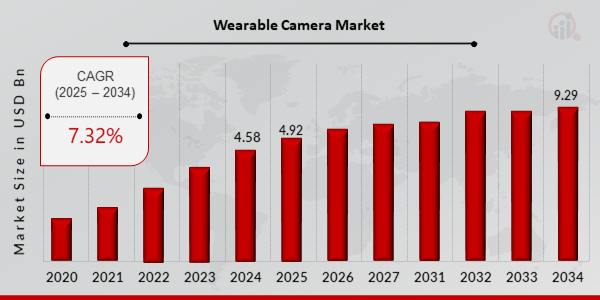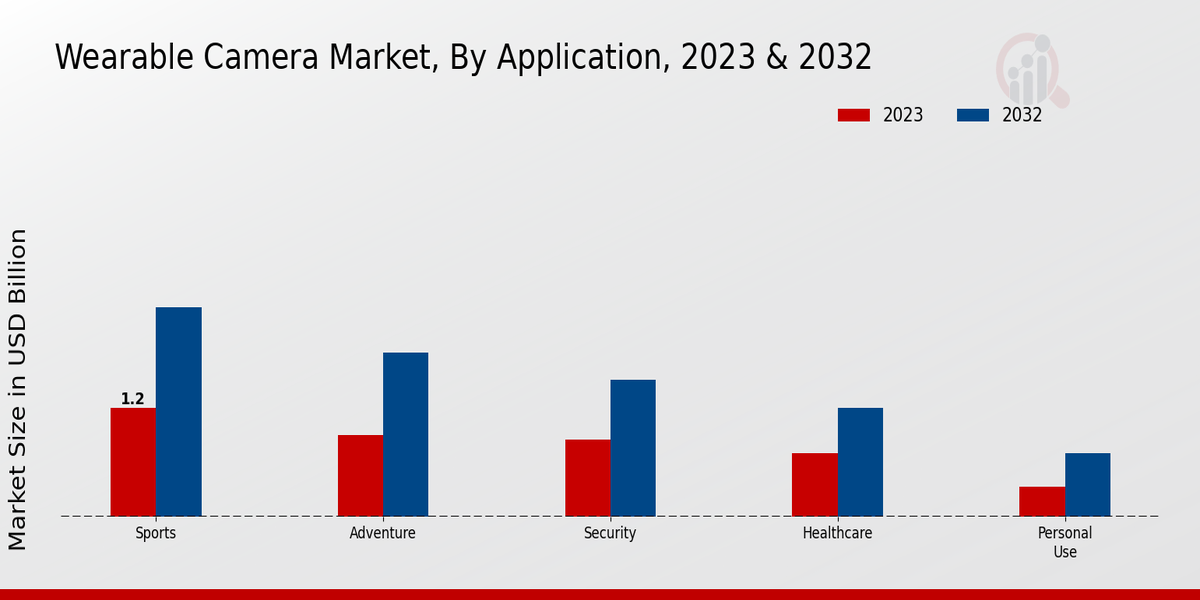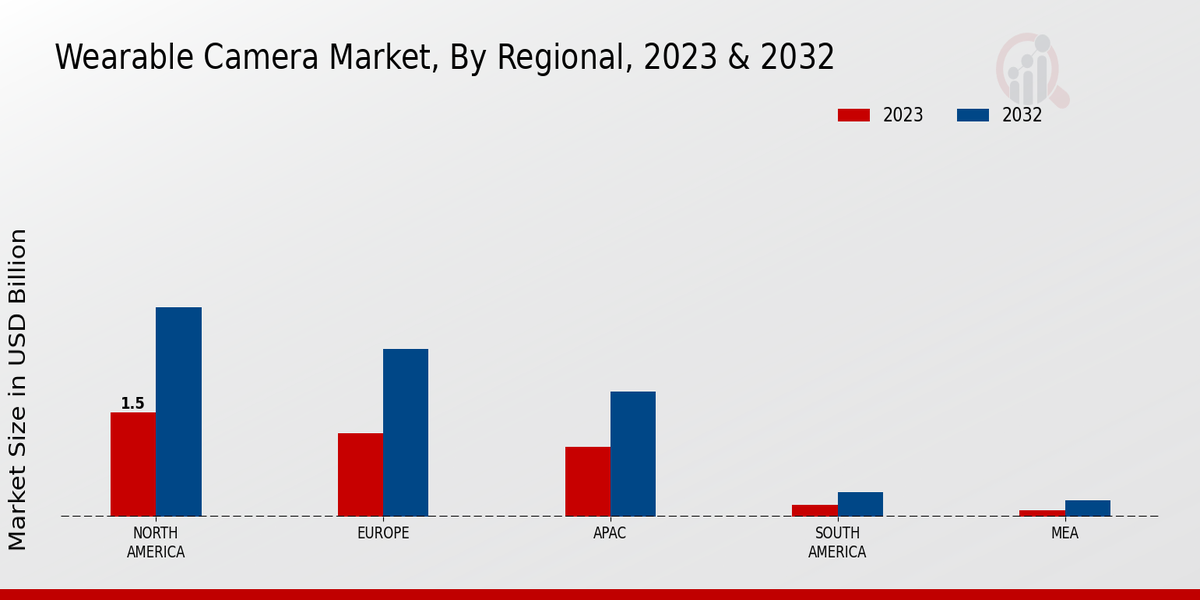Global Wearable Camera Market Overview
Wearable Camera Market Size was estimated at 4.58 (USD Billion) in 2024. The Wearable Camera Market Industry is expected to grow from 4.92 (USD Billion) in 2025 to 9.29 (USD Billion) till 2034, exhibiting a compound annual growth rate (CAGR) of 7.32% during the forecast period (2025 - 2034)
Key Wearable Camera Market Trends Highlighted
The Wearable Camera Market is being driven by the increasing demand for portable and high-quality video recording devices. As technology advances, consumers are looking for compact devices that offer excellent imaging capabilities for activities such as travel, sports, and personal storytelling. Additionally, the rising popularity of social media platforms is encouraging users to capture and share their experiences, leading to greater interest in wearable cameras that provide hands-free operation and ease of use. Enhanced image stabilization, longer battery life, and connectivity features like Wi-Fi and Bluetooth are also contributing to market growth.
Opportunities in the market can be explored through innovations in design and functionality. Companies can focus on developing more versatile cameras that can withstand extreme conditions and integrate with other smart devices. Enhanced features such as augmented reality and virtual reality compatibility present pathways to attract a broader user base. There is also potential for partnerships with influencers and content creators who value high-quality visual content, further boosting brand visibility. Expanding into emerging markets where there is a growing interest in outdoor activities and adventure sports can offer significant growth avenues.
Recent trends highlight a shift towards more specialized wearable cameras tailored for specific activities, such as those designed for extreme sports or wildlife observation. Integration with mobile apps for editing and sharing content is becoming a key feature. Moreover, sustainability is gaining traction, pushing manufacturers to consider eco-friendly materials in their products. As consumers become more health-conscious, wearables that track fitness and health metrics alongside visual recording capabilities may also see increased adoption. The changing landscape of consumer preferences continues to shape this evolving market.

Source: Primary Research, Secondary Research, MRFR Database and Analyst Review
Wearable Camera Market Drivers
Rising Popularity of Adventure Sports and Outdoor Activities
The Wearable Camera Market industry is witnessing significant growth due to the increasing popularity of adventure sports and outdoor activities among consumers. As more individuals seek experiences that allow them to engage with nature or indulge in thrilling activities like skiing, biking, hiking, and rock climbing, there is a corresponding demand for high-quality cameras that can capture these experiences. These wearable cameras provide users with the ability to document their adventures hands-free, ensuring that they can fully immerse themselves in the experience while still recording everything with precision.
Furthermore, advancements in camera technology have led to features such as high-resolution video recording, image stabilization, and waterproof capabilities, making wearable cameras an attractive accessory for outdoor enthusiasts. This trend not only caters to individual users but also provides valuable content creation opportunities for bloggers, social media influencers, and content creators who rely on wearable cameras to engage their audiences.
As this segment of the consumer base continues to grow, the Wearable Camera Market industry is expected to flourish, driven by the desire for innovative, hands-free recording solutions that enhance the experience of adventure and exploration.
Advancements in Camera Technology
Technological advancements in camera features, such as enhanced image quality, improved stabilization, and integration with mobile devices, are driving the growth of the Wearable Camera Market industry. As manufacturers innovate and introduce new features, consumers are becoming more inclined to purchase wearable cameras to capture high-quality images and videos effortlessly. These advancements not only improve user experience but also expand the range of applications for wearable cameras in various fields, from sports to marketing.
Growing Adoption in Professional Applications
The increasing adoption of wearable cameras in professional settings, such as law enforcement, healthcare, and sports analysis, is contributing to the growth of the Wearable Camera Market industry. Professionals leverage these cameras for training, documentation, and data collection, leading to a higher demand for specialized models that cater to these needs. As more industries recognize the benefits of wearable cameras, the market is poised for substantial expansion.
Wearable Camera Market Segment Insights:
Wearable Camera Market Application Insights
The Wearable Camera Market presents a diverse range of applications, contributing significantly to the overall market revenue, which is expected to reach 3.98 USD Billion in 2023 and grow to 7.5 USD Billion by 2032. The segmentation of this market reveals key areas of focus, such as Sports, Adventure, Security, Healthcare and Personal Use. Among these, the Sports application holds a majority share and is valued at 1.2 USD Billion in 2023, reflecting a growing trend where athletes and enthusiasts utilize wearable cameras to capture high-action moments and enhance viewer experience. This segment not only dominates in terms of valuation but also actively drives market growth as more participants look for ways to document their sporting achievements.
The Adventure application, valued at 0.9 USD Billion in 2023, also plays a significant role, appealing to outdoor enthusiasts who use wearable cameras to document their experiences in extreme environments, thus supporting the expanding adventure tourism market. In the Security application, valued at 0.85 USD Billion in 2023, wearable cameras are utilized widely by law enforcement and personal security operators to enhance safety and surveillance, indicating a critical demand in urban settings. The Healthcare segment, valued at 0.7 USD Billion, showcases a rising trend of using wearable cameras for telemedicine and remote patient monitoring, highlighting innovation in healthcare solutions where visual documentation is essential.
Lastly, the Personal Use segment, while smaller, valued at 0.33 USD Billion, presents a growing opportunity as consumers seek to document daily experiences through a more personal lens, supported by advancements in camera technology that enhance user experience. This varied yet interconnected segmentation in the Wearable Camera Market illustrates not only the diversity of use cases but also the resilience of the industry, fueled by technological advancements and changing consumer preferences, ultimately enabling growth across all application areas.

Source: Primary Research, Secondary Research, MRFR Database and Analyst Review
Wearable Camera Market Type Insights
This rapid development can be attributed to the increasing popularity of wearable technology and the rising need for real-time video recording in various sectors. Among the types of wearable cameras, Body Mounted Cameras have gained traction, especially in security and law enforcement sectors, due to their hands-free operation and ability to capture vital footage.
Head Mounted Cameras are notable for their use in immersive experiences, particularly in gaming and virtual reality, enhancing user interaction. Wearable Action Cameras remain a favorite for adventure enthusiasts, offering durability and high-quality video capturing in extreme conditions. Smart Glasses have started to carve a niche in the market, providing augmented reality experiences that blend digital information with the real world.
As the Wearable Camera Market segmentation expands, each type contributes uniquely to market growth, driven by technological advancements, consumer demand for convenience and the expanding applications in diverse fields. Overall, the market data reflects a robust landscape ripe with opportunities for innovation and increased penetration in everyday activities.
Wearable Camera Market Connectivity Insights
This segment encompasses various technologies, including Wi-Fi, Bluetooth, Cellular, and USB, each playing a pivotal role in enhancing the functionality and user experience of wearable cameras. Wi-Fi technology enables high-definition video streaming and quick file sharing, making it particularly significant for users who rely on instant uploads to social media or cloud storage. Bluetooth is also important for short-range connectivity, allowing seamless synchronization with smartphones and remote controls.
Although Cellular connectivity is less prevalent, it provides a vital solution for users requiring real-time data transmission in remote areas. USB connections remain essential for charging and data transfer, ensuring the devices maintain functionality and convenience. The synergy among these technologies drives market growth, supported by increasing consumer demand for advanced features and improved connectivity in wearable devices. Understanding the Wearable Camera Market segmentation highlights the industry's evolution and its response to emerging trends and consumer preferences.
Wearable Camera Market End Use Insights
This segmentation reveals significant opportunities with a focus on Professional, Amateur and Commercial users. The Professional end use represents a vital segment where wearable cameras enhance the work of individuals in fields such as filmmaking, sports, and law enforcement, providing them with innovative tools for high-quality capture and documentation. In the Amateur category, the devices appeal to enthusiastic users who seek convenience and quality in personal recordings, especially in outdoor and travel settings.
Meanwhile, the Commercial segment plays an essential role, catering to businesses that utilize wearable cameras for marketing, training, and customer engagement, thereby driving demand and facilitating growth. By analyzing Wearable Camera Market data, we see that factors such as advancements in camera technology, increasing consumer interest, and rising demand in various sectors contribute to market growth. However, challenges, including privacy concerns and competition among brands, may impact the overall landscape. As the market evolves, numerous opportunities for innovation and improvement remain, setting the stage for broader adoption and expansion of wearable cameras in day-to-day life and specialized environments.
Wearable Camera Market Regional Insights
The Wearable Camera Market revenue displays a promising growth trajectory across various regions, primarily driven by technological advancements and rising consumer interest in personal recording devices. Among the regional segments, North America holds a significant market presence with a valuation of 1.5 USD Billion in 2023 and is expected to double by 2032, reflecting a majority holding due to high adoption rates and consumer sophistication in this region.
Europe follows closely, with a market valuation of 1.2 USD Billion in 2023, supported by increasing penetration of wearable technology and a growing trend of content sharing among users.APAC showcases a growing interest in wearable cameras, valued at 1.0 USD Billion, influenced by competitive pricing and rising economic levels that enhance consumer spending.
South America and MEA represent the smaller markets, valued at 0.18 USD Billion and 0.1 USD Billion, respectively, in 2023, indicating significant growth opportunities for market players looking to expand into emerging markets. Overall, the Wearable Camera Market statistics reveal a diverse landscape, with each region emphasizing unique opportunities for growth and consumer engagement.

Source: Primary Research, Secondary Research, MRFR Database and Analyst Review
Wearable Camera Market Key Players and Competitive Insights:
The Wearable Camera Market has gained significant traction in recent years, driven by technological advancements and an increasing demand for portable photography and videography solutions. With applications ranging from sports and adventure activities to personal storytelling and content creation, the competition in this sector is robust. Key players are continuously innovating to enhance features such as image quality, battery life, and durability. Moreover, the integration of connectivity options such as Wi-Fi and Bluetooth has raised consumer expectations for seamless sharing and remote control capabilities.
The market landscape is characterized by a mix of established companies and emerging startups that are pushing the boundaries of wearable technology. As the market evolves, consumers are likely to see a greater emphasis on user-friendly designs and specialized functionalities tailored to niche markets.DJI has established itself as a dominant player within the Wearable Camera Market through its exceptional reputation for high-quality imaging and stability technology. Known primarily for its drone technology, DJI has successfully translated its expertise into the development of advanced wearable cameras that cater to a wide array of consumers.
The company's focus on innovation is evident in its product offerings, which often feature cutting-edge optical stabilization and seamless integration with existing DJI ecosystems. Furthermore, DJI has effectively leveraged its strong brand presence and customer loyalty, allowing its wearable cameras to stand out in a crowded market. With a solid distribution network and a commitment to customer support, DJI sits in a favorable position to capitalize on the growing trend of content creation and adventure sports.
On the other hand, Nikon has carved a niche for itself in the Wearable Camera Market by emphasizing its rich heritage in photography and imaging technology. While the brand is better known for its traditional cameras, Nikon has made strategic moves to adapt its offerings to cater to the needs of consumers looking for wearable solutions. The company integrates advanced imaging technology that ensures users achieve high-quality photos and videos, often characterized by vibrant colors and excellent low-light performance. In addition, Nikon benefits from a strong reputation among photography enthusiasts, which bolsters its credibility in the expanding wearable market.
By developing products that combine user-friendly features with professional-grade quality, Nikon continues to appeal to both amateur and experienced users, exploring the advantages of wearable cameras. Its continued investment in research and development indicates a commitment to enhancing its technology and capturing a greater share of the wearable camera segment.
Key Companies in the Wearable Camera Market Include:
- DJI
- Nikon
- Samsung
- Garmin
- GoPro
- Kodak
- Philips
- Sony
- Ricoh
- Insta360
- Vuzix
- Fitbit
- Canon
- Snap
- TomTom
Wearable Camera Market Industry Developments
Recent developments in the Wearable Camera Market have seen significant innovations and competitive movements among key players. For instance, DJI continues to enhance its camera technology, targeting new markets with advanced stabilization features, while Nikon is focusing on integrating AI into its products for improved user experience. Meanwhile, Samsung is exploring partnerships to strengthen its market position in wearable cameras, leveraging its extensive tech ecosystem. GoPro remains a market leader with its latest HERO models, appealing to both amateur and professional users. Garmin is expanding its offerings with robust action cameras designed for the outdoor and fitness markets.
Notably, Kodak has returned to the space by introducing new compact cameras optimized for social media sharing. Recent market valuation growth for companies like Sony and Canon, driven by an increasing demand for high-quality portable recording devices, has made the segment more lucrative. Regarding mergers and acquisitions, there have been speculations about consolidation among smaller firms, but no major announcements from the targeted key players such as Ricoh, Insta360, Vuzix, or Fitbit, signaling any significant partnerships or acquisitions at this time. The landscape remains dynamic as companies adapt to evolving consumer preferences.
Wearable Camera Market Segmentation Insights
Wearable Camera Market Application Outlook
- Sports
- Adventure
- Security
- Healthcare
- Personal Use
Wearable Camera Market Type Outlook
- Body Mounted Cameras
- Head Mounted Cameras
- Wearable Action Cameras
- Smart Glasses
Wearable Camera Market Connectivity Outlook
- Wi-Fi
- Bluetooth
- Cellular
- USB
Wearable Camera Market End Use Outlook
- Professional
- Amateur
- Commercial
Wearable Camera Market Regional Outlook
- North America
- Europe
- South America
- Asia Pacific
- Middle East and Africa
|
Report Attribute/Metric
|
Details
|
|
Market Size 2024
|
USD 4.58 Billion
|
|
Market Size 2025
|
USD 4.92 Billion
|
|
Market Size 2034
|
USD 9.29 Billion
|
|
Compound Annual Growth Rate (CAGR)
|
7.32% (2025-2034)
|
|
Base Year
|
2024
|
|
Market Forecast Period
|
2025-2034
|
|
Historical Data
|
2020-2023
|
| Market Forecast Units |
USD Billion |
|
Report Coverage
|
Revenue Forecast, Competitive Landscape, Growth Factors, and Trends
|
| Key Companies Profiled |
DJI, Nikon, Samsung, Garmin, GoPro, Kodak, Philips, Sony, Ricoh, Insta360, Vuzix, Fitbit, Canon, Snap, TomTom |
| Segments Covered |
Application, Type, Connectivity, End Use, Regional |
| Key Market Opportunities |
Enhanced outdoor activities demandGrowth in adventure tourism Adoption in law enforcement sectorsIntegration with smart devicesRise of user-generated content platforms |
| Key Market Dynamics |
Technological advancements, Growing outdoor activities, Increasing social media influenceRising demand for security, Enhanced image quality |
| Countries Covered |
North America, Europe, APAC, South America, MEA |
Frequently Asked Questions (FAQ) :
The Wearable Camera Market was projected to be valued at 9.29 USD Billion in 2034.
The expected CAGR for the Wearable Camera Market from 2025 to 2034 is 7.32%.
North America holds the largest market share in the Wearable Camera Market, with a value of 1.5 USD Billion in 2023.
The Sports application segment is valued at 1.2 USD Billion in the Wearable Camera Market for 2023.
The Adventure application segment is projected to reach a market value of 1.8 USD Billion in 2032.
Key players in the Wearable Camera Market include DJI, Nikon, Samsung, Garmin, and GoPro.
The Security application segment is projected to be valued at 1.5 USD Billion in 2032.
The Healthcare application segment is expected to grow from 0.7 USD Billion in 2023 to 1.2 USD Billion in 2032.
The expected market size for the APAC region in 2032 is 1.8 USD Billion.
The market value for Personal Use applications is 0.33 USD Billion in 2023.

















